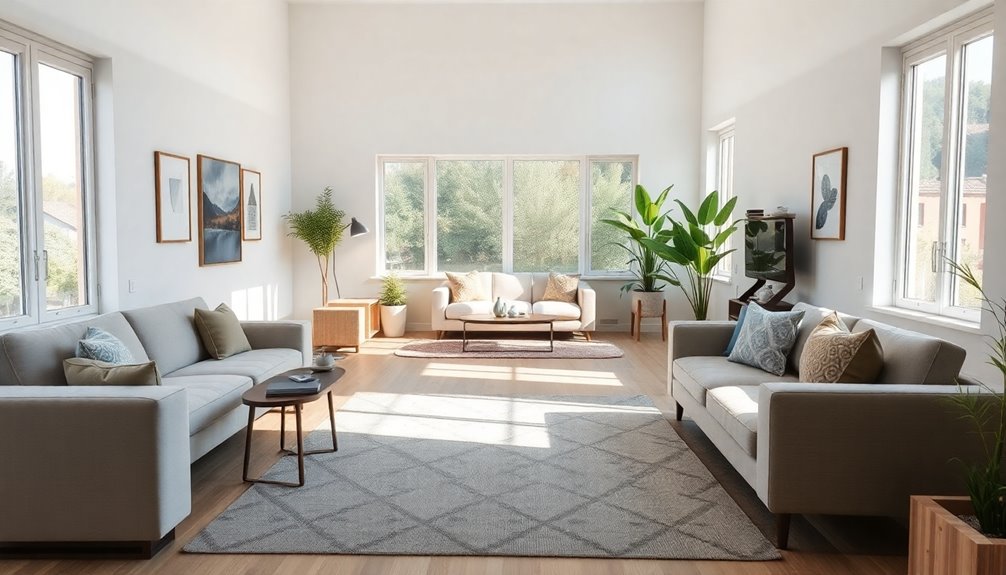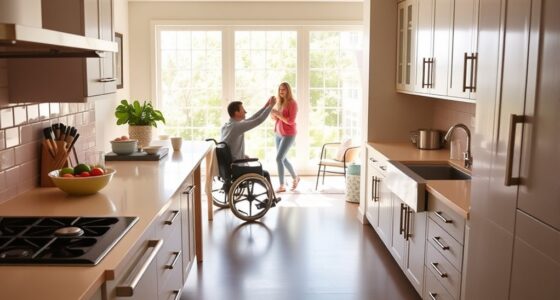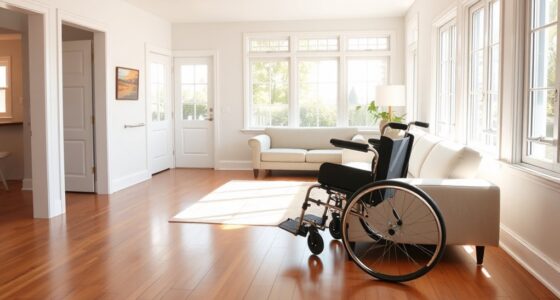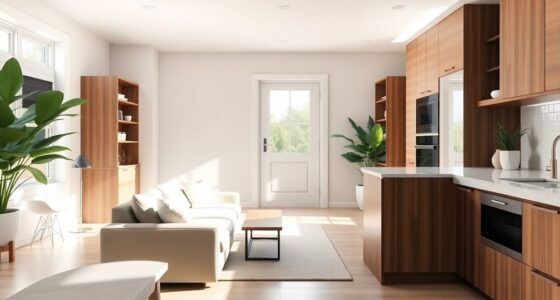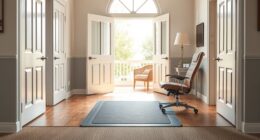You won't believe how universal design ideas transform your home into an accessible and comfortable space. Imagine having efficient light sensors that adjust based on occupancy and a curbless shower for easy access. Picture a wheelchair-accessible bedroom with wide doorways, ensuring everyone can move freely. Added features like slip-resistant flooring and family-friendly faucets make daily tasks simpler and safer. These changes not only enhance functionality but also uplift the overall aesthetic of your home. There's so much more to discover!
Key Takeaways
- Efficient lighting and safety features enhance accessibility, reduce energy use, and improve safety for all household members, regardless of ability.
- Curbless, doorless showers eliminate barriers, promoting independence and safety while creating a serene bathroom environment.
- Wheelchair-accessible bedrooms with wide doorways allow for easy maneuverability and enhance independence for individuals with mobility challenges.
- Slip-resistant flooring is crucial in preventing falls, especially in high-traffic areas, benefiting seniors and those with mobility issues.
- Adhering to the principles of universal design fosters inclusivity, ensuring that spaces are functional and safe for everyone, regardless of their abilities.
Efficient, Helpful Light Sensor
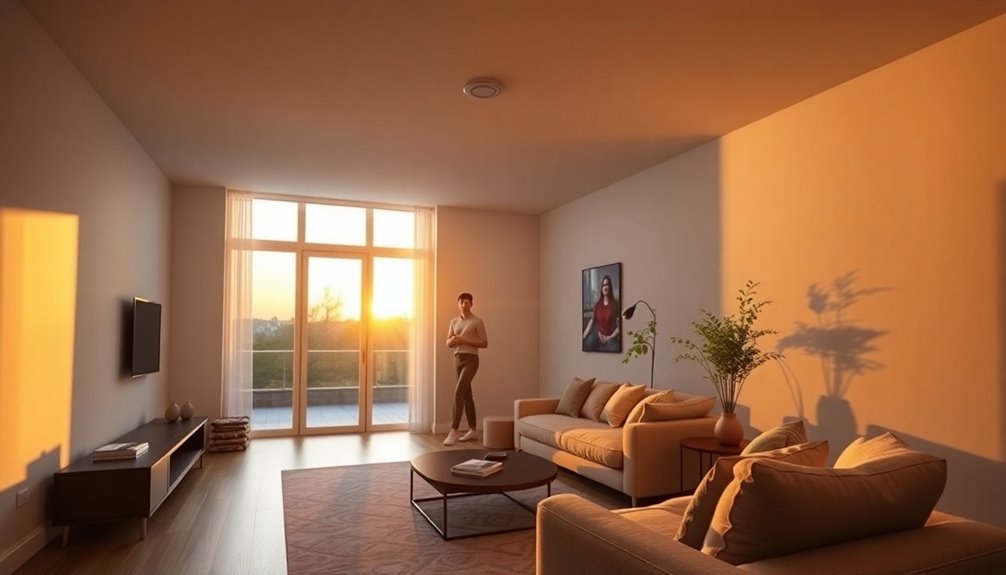
When you install efficient light sensors in your home, they automatically detect when someone enters or leaves a room, adjusting the lighting accordingly.
This universal design feature enhances accessibility, especially for individuals with mobility challenges who may struggle with manual switches. The convenience of having lights turn on and off as needed benefits everyone, including children and seniors.
By reducing unnecessary electricity usage, these sensors contribute to energy savings, making your home more eco-friendly. Additionally, they improve safety by illuminating pathways in low-light conditions, reducing the risk of falls and accidents.
With light sensors, you create a more inclusive environment that caters to the needs of all household members while promoting a sustainable lifestyle. Furthermore, energy-efficient operation of light sensors aligns with the principles of modern air purifiers, which also aim to reduce electricity costs while enhancing home comfort.
A Home That Looks Like Home
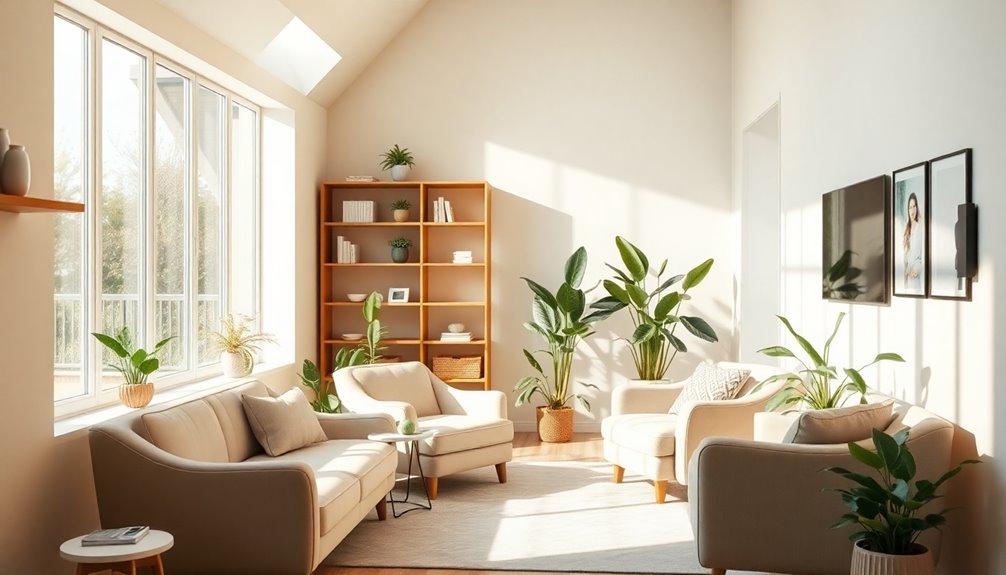
Creating a home that feels inviting and functional for everyone is key to universal design. By embracing inclusive design principles, you can blend style with accessibility, ensuring your space is both beautiful and practical.
Think about incorporating stylish grab bars and ergonomically designed furniture; these elements enhance aesthetics without sacrificing safety. Features like wider doorways and single-handle faucets not only improve usability for those with mobility challenges but also elevate the overall design of your home.
Lever door handles add a modern touch while making it easier for everyone to navigate. With a little creativity in your home adaptations, you can personalize your space while keeping it welcoming and functional for all family members. Additionally, consider proper venting to maintain a safe and comfortable environment throughout your home.
Curbless, Doorless Shower
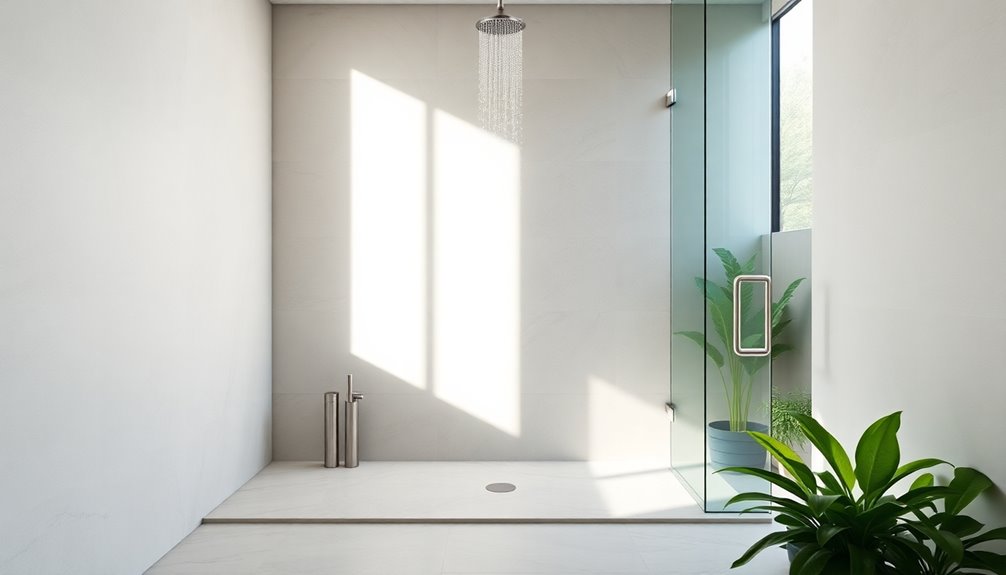
A curbless, doorless shower transforms your bathroom into a space that's not only stylish but also accessible for everyone.
This universal design eliminates barriers, allowing easy access for individuals of all ages and abilities. You'll appreciate the safety it provides, reducing the risk of tripping and falls.
Consider these benefits of a curbless shower:
- Enhanced accessibility for walkers and wheelchairs
- Minimalist look that elevates your bathroom's aesthetic
- Spacious feel without doors, promoting independence
- Adjustable shower heads for all heights and mobility levels
Additionally, incorporating natural elements like wood and stone can further enhance the serene atmosphere of your curbless shower space.
Wheelchair-Accessible Bedroom
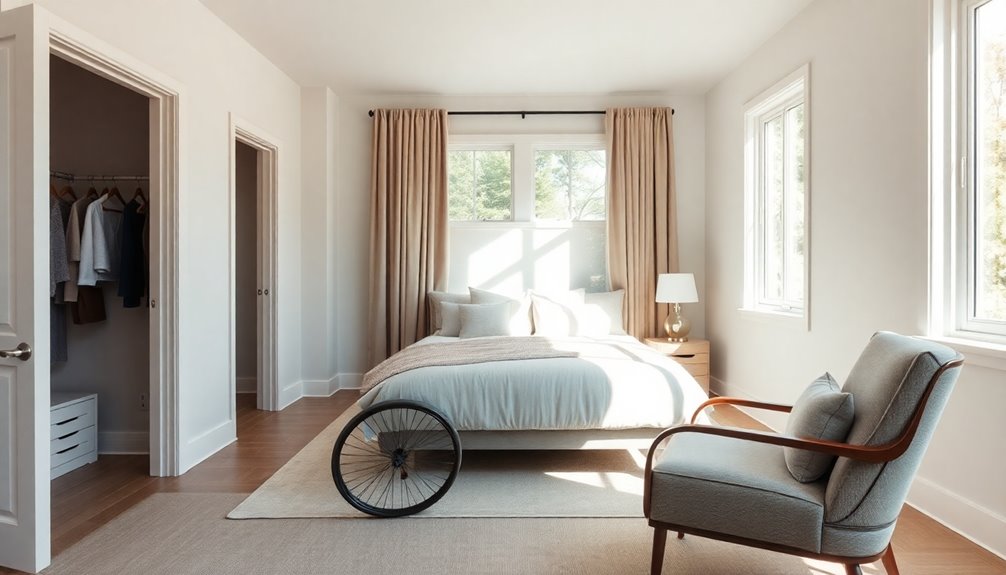
Ensuring your bedroom is wheelchair-accessible not only enhances comfort but also promotes independence for users with mobility challenges.
Start by installing a doorway that's at least 32 inches wide, allowing easy maneuverability. Aim for a layout with a minimum of 5 feet in diameter for turning space, free of obstacles.
Bed height is essential; choose one between 18 to 24 inches to make transferring from a wheelchair easier. For storage, design closets and drawers at accessible heights so you can reach items while seated.
Consider adjustable furnishings, like bedside tables that can be set to varying heights, to further boost accessibility. Incorporating smart features like voice-activated assistants can also enhance the overall functionality of the space.
These thoughtful design products make a significant difference in creating a welcoming and functional space.
Family-Friendly Faucet
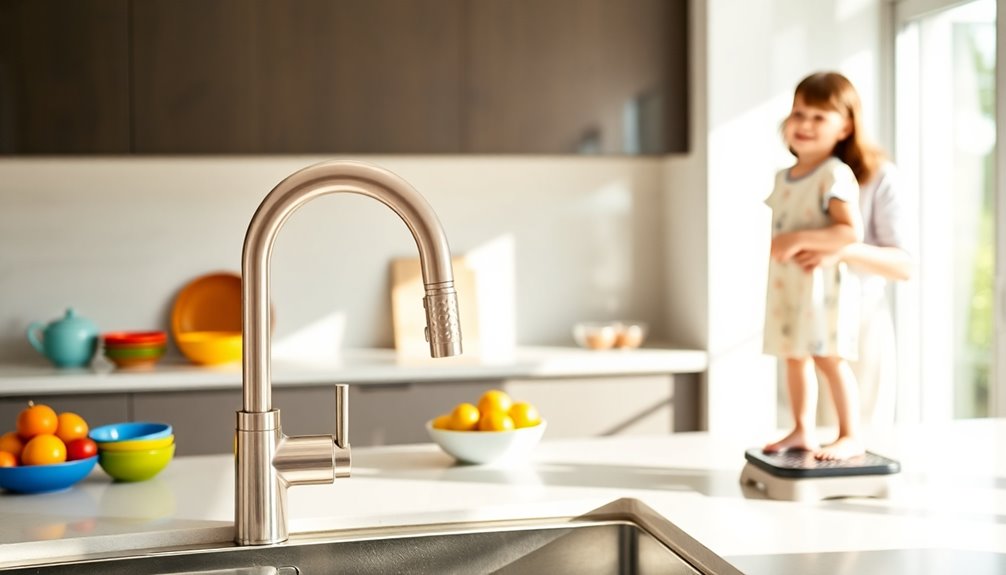
When it comes to family-friendly faucets, opting for single-handle designs makes adjustments to water temperature a breeze for everyone, from kids to seniors.
These faucets enhance accessibility in your kitchen, ensuring safety and ease of use.
Consider these features:
- High-arc spouts for ample space to fill pots and wash large dishes.
- Touchless or motion-sensor technology that promotes hygiene and minimizes germ spread.
- Single-handle operation for quick temperature adjustments with one hand.
- Temperature control designs to prevent accidental scalding, especially for young children.
Additionally, selecting faucets with water efficiency features can further contribute to conservation efforts in your home.
These universal design elements not only streamline cooking and cleaning tasks but also create a safer, more efficient environment for your entire family.
Beautifully Safe Bathroom
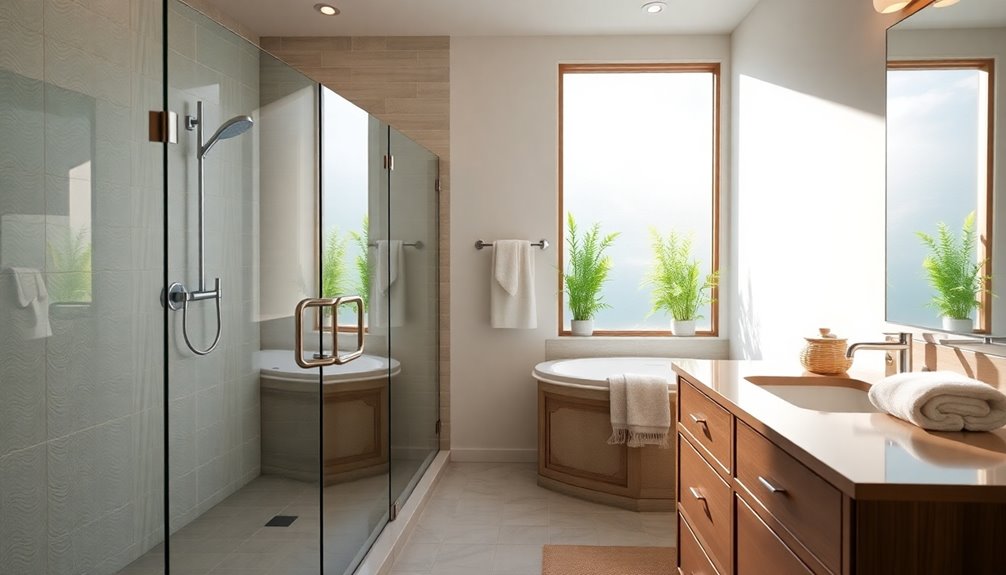
Creating a beautifully safe bathroom means blending style with functionality, so you can enjoy a space that's both attractive and accessible.
By incorporating universal design principles, you enhance accessibility for everyone. Lever handles on doors and drawers make it easy for users of all ages to operate without excessive force. Visual cues, like contrasting colors, help quickly locate handles and fixtures.
Safety features, such as strategically placed grab bars and slip-resistant flooring, greatly reduce the risk of falls, creating a safer environment. Adjustable lighting and motion sensors not only improve convenience but also guarantee lights are on when you need them, especially for those with mobility challenges. Additionally, implementing energy-efficient technology can further enhance the overall comfort and sustainability of your bathroom.
Transform your bathroom into a stylish haven that prioritizes safety and usability.
Wide Doorways
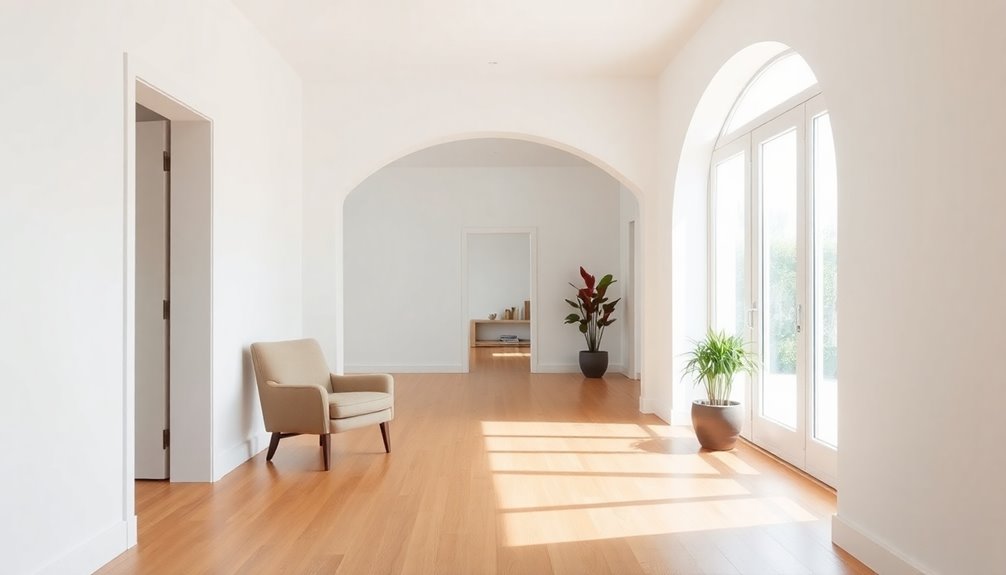
When you consider wide doorways, think about how they enhance mobility flow in your home.
Not only do they provide accessible design benefits for everyone, but they also promote safety and convenience, reducing trip hazards. Moreover, homes without security systems are 300% more likely to be burglarized, highlighting the importance of a well-designed, secure environment for all residents.
Enhanced Mobility Flow
Wide doorways undeniably transform how people navigate their homes, making spaces more accessible and inviting. By incorporating wider doorways, you enhance mobility and create a universal design that benefits everyone.
Consider these advantages:
- Easier movement for individuals using wheelchairs, walkers, or other mobility aids
- Elimination of curbs at doorways to reduce trip hazards for children and seniors
- Improved traffic flow, allowing seamless shifts between rooms
- Fostering social interaction as family and guests move around comfortably
With these features, your home becomes a safer and more inclusive environment.
Ultimately, wide doorways not only enhance accessibility today but also accommodate future needs, ensuring everyone can navigate your space with ease.
Accessible Design Benefits
Transforming your space with wider doorways not only enhances mobility but also brings a host of benefits that make your home more accessible.
Wider doorways, typically 36 inches or more, facilitate movement for people with disabilities, ensuring that everyone, including those using wheelchairs or strollers, can navigate easily.
By eliminating curbs at doorways, you reduce trip hazards, making your home safer for children and the elderly. Improved traffic flow allows caregivers to assist those with mobility challenges more effectively.
Additionally, incorporating wide doorways promotes independence, allowing residents of all ages to age in place. Advance directives can further enhance safety by ensuring that medical decisions are made in accordance with the individual's wishes.
Ultimately, good design that includes wider doorways increases accessibility and usability, ensuring all family members can participate in daily activities together.
Safety and Convenience
Creating a home environment with wide doorways greatly enhances your safety and convenience. When you incorporate wider doorways, you'll notice significant benefits that improve accessibility for everyone.
Consider these advantages:
- Easier movement for individuals using wheelchairs or walkers.
- Reduced trip hazards with the elimination of curbs, making it safer for children and seniors.
- Improved traffic flow, allowing multiple people to move comfortably during gatherings.
- Increased property value by appealing to a broader range of potential buyers.
With wide doorways, you're promoting inclusivity and independence for those with mobility challenges, allowing them to navigate spaces without barriers. Additionally, creating a safe environment contributes to better emotional regulation, which is essential for the overall well-being of all family members.
Bathroom Bench

A bathroom bench can greatly enhance your shower safety, providing a secure place to sit while you groom or wash.
With its versatile design, it promotes independence and comfort for everyone, regardless of mobility.
Plus, when paired with adjustable shower heads and grab bars, it transforms your space into a practical yet spa-like retreat. Additionally, a clean and organized bathroom can reduce allergens and pollutants, contributing to a healthier living environment.
Enhancing Shower Safety
When it comes to enhancing shower safety, incorporating a bathroom bench can make a significant difference. These universal design features provide a safe seating option, reducing the risk of slips and falls in wet areas.
Consider the following benefits of bathroom benches:
- They offer support and stability, especially for those shifting from mobility aids.
- They can be paired with grab bars for added safety.
- Adjustable shower heads can accommodate users of different heights.
- They create a spa-like atmosphere, making the space more inviting for everyone.
Promoting Independence and Comfort
While many people overlook the importance of seating in the bathroom, having a bathroom bench can greatly enhance your independence and comfort during daily routines. These benches provide a stable seating option, promoting safety as you shower or groom. They allow you to sit while bathing, perfect for anyone making a shift from mobility aids or feeling fatigued.
| Feature | Benefits | Impact on Users |
|---|---|---|
| Adjustable Shower Head | Easy access for all heights | Increased usability |
| Grab Bars | Added support in wet areas | Reduced risk of slips |
| Spa-like Atmosphere | Inviting and relaxing space | Enhanced comfort |
| Stability | Safe seating during routines | Greater independence |
Embrace the comfort and safety a bathroom bench brings to your space!
Versatile Design for All
Incorporating a bathroom bench into your space not only elevates safety but also enhances the overall design, making it a versatile addition for everyone.
This universal design element accommodates people of all ages, creating environments to make everyday routines easier and more enjoyable.
- Provides stable seating for showering and grooming
- Adjustable shower heads make it easy to reach water while seated
- Grab bars enhance safety when entering or exiting the shower
- Stylish designs blend seamlessly with your bathroom decor
With a bathroom bench, you encourage relaxation and transform your bathroom into a spa-like retreat.
It's not just about functionality; it's about creating a space that serves everyone, regardless of their needs or abilities.
Slip-Resistant Floor
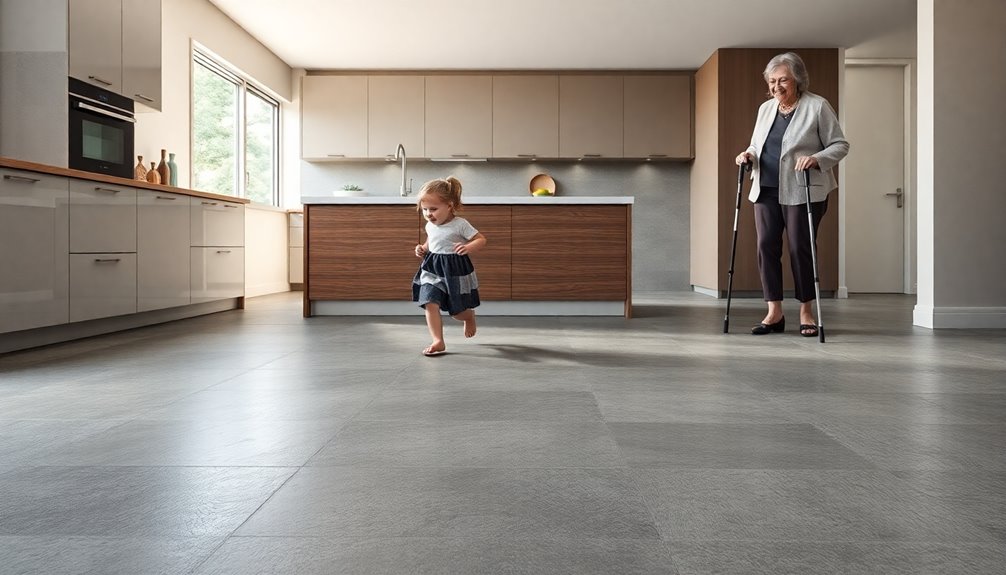
Creating a safe environment often hinges on the choice of flooring, especially in high-traffic areas where slips and falls can pose significant risks.
Slip-resistant flooring is essential, particularly for seniors and individuals facing mobility challenges. Choosing materials like cork not only provides a soft underfoot feel but also enhances safety with its slip-resistant properties.
If you're looking for a cost-effective solution, consider applying treatments to existing floors to boost slip resistance. Modular carpet tiles can replace hazardous mats, offering easy maintenance and customization while promoting a safer space.
The 7 Principles of Universal Design and Why They're Important

When you explore the 7 Principles of Universal Design, you'll find they focus on making spaces and products accessible to everyone.
Each principle, from Equitable Use to Tolerance for Error, offers unique benefits that enhance usability for all individuals.
Understanding these principles can help you create more inclusive environments that cater to diverse needs.
Key Principles Overview
Universal Design hinges on seven key principles that make products and environments accessible and enjoyable for everyone, regardless of their abilities.
Understanding these principles helps you create spaces that foster inclusivity and usability.
Here are four essential principles:
- Equitable Use: Designs are usable by diverse abilities without stigmatization.
- Simple and Intuitive Use: Designs are easy to understand, reducing the learning curve.
- Tolerance for Error: Designs minimize hazards and adverse consequences of accidental actions.
- Low Physical Effort: Designs require minimal effort to use, enhancing comfort and accessibility.
Benefits for All Users
Designing with inclusivity in mind not only benefits individuals with diverse abilities but enhances the experience for everyone.
The 7 Principles of Universal Design create products that are universally designed to be functional for all users. Equitable Use guarantees designs benefit everyone, while Flexibility in Use accommodates individual preferences.
With Simple and Intuitive Use, you can easily navigate products without confusion, making daily tasks more manageable. Tolerance for Error helps prevent accidents and fosters a safer environment, boosting your confidence.
By prioritizing these principles, you create spaces and products that help everyone thrive, leading to a more inclusive society where each person can enjoy equal access and satisfaction.
Embrace universal design, and watch your world become more accessible!
Frequently Asked Questions
How Does Universal Design Benefit Everyone?
Universal design benefits everyone by creating spaces and products that are accessible and easy to use.
You'll find that features like wider doorways and curbless showers help not just those with disabilities but also parents with strollers or anyone carrying heavy items.
With intuitive designs like motion-sensor lights and single-handle faucets, everyday tasks become simpler and more efficient.
Ultimately, universal design fosters a sense of belonging and satisfaction for all users, regardless of their abilities.
What Are Examples of Universal Design in Everyday Life?
Universal design is all around you, making everyday life more accessible. For instance, you might notice automatic sliding doors that open effortlessly, curb cuts for smoother navigation, and clear directional signage that helps you find your way.
In public restrooms, motion-sensor faucets and hand dryers promote hygiene without needing to touch anything. Ergonomic kitchen utensils, like those from OXO, allow for comfortable cooking, catering to everyone, regardless of their physical abilities.
What Is Universal Design for Living?
Universal design for living creates spaces that everyone can access and enjoy, regardless of age or ability.
It incorporates features like wide doorways, curbless showers, and intuitive layouts to enhance safety and mobility.
You'll find that this approach emphasizes flexibility and simplicity, making everyday environments more functional.
Why Are the 7 Principles of Universal Design Important?
The 7 principles of universal design are essential because they guarantee products and environments meet everyone's needs, regardless of ability.
By promoting equitable use, you create spaces that welcome diverse users without discrimination.
Flexibility in use allows you to customize your experience, making it more enjoyable.
Simple and intuitive designs reduce confusion, while tolerance for error enhances safety.
Conclusion
So, imagine walking into a home where every feature just clicks with your lifestyle. With these 10 universal design ideas, you're not just enhancing accessibility; you're creating a space that feels welcoming for everyone, from kids to grandparents. You might find that a curbless shower or a family-friendly faucet isn't just practical—it transforms your daily routine into something smoother and more enjoyable. Coincidentally, you're not just improving your home; you're enriching your life and those around you.
